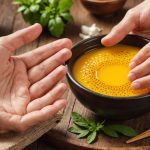Key Ingredients for Hydration
Achieving optimal skin hydration requires the incorporation of strategic moisturizing ingredients in face masks. Among these, hyaluronic acid is highly regarded for its ability to attract and retain moisture, acting as a powerful moisture magnet. This naturally occurring substance can hold up to 1,000 times its weight in water, ensuring that your skin remains plump and hydrated.
Glycerin, another key player, acts as a barrier to prevent moisture loss while simultaneously drawing water into the outer layer of the skin. It effectively seals in hydration, ensuring that any moisture provided by products is locked in for extended periods.
In the same genre : Revitalize your tresses: the ultimate guide to the best deep conditioning hair masks for repair and nourishment
Natural oils such as jojoba and coconut oil also play a vital role in moisturizing. These oils mimic the skin’s natural sebum, creating a protective layer that prevents water from evaporating. Jojoba oil is especially beneficial for its non-comedogenic properties, making it suitable for a variety of skin types without clogging pores.
In incorporating these ingredients into face masks, you tap into their unique benefits, ensuring your skincare routine is both effective and targeted. Using effective face masks with such components can elevate your skincare regimen, providing lasting hydration and revitalizing your complexion.
In the same genre : Elevate your manicure: the best nail shapes for short nails that will transform your look!
Understanding Different Textures and Formulations
In the realm of face masks, choosing the right texture and formulation is essential for skin hydration and overall effectiveness. Deciphering between gel and cream masks can revolutionize your skincare regimen. Gel masks are lightweight with a cooling effect, absorbing rapidly into the skin without leaving any residue. This makes them ideal for those seeking immediate moisture absorption. In contrast, cream masks have a thicker texture, which provides intense hydration over extended periods, beneficial for drier skin types that need a prolonged moisturizing effect.
Sheet Masks
Sheet masks have risen in popularity due to their convenience and instant results. These pre-soaked masks adhere to the face, ensuring even distribution of nutrients and facilitating deep skin hydration. They are perfect for quick skincare routines.
Overnight Masks
For those looking for continual hydration, overnight masks are a fantastic option. These rich, creamy formulations are designed to work while you sleep, maximizing your skin’s natural repair processes. They provide excellent skin hydration, ensuring you wake up with a refreshed, revitalized complexion. Through these textured options, face masks cater to various skin needs, enhancing your overall skincare routine.
Matching Masks to Skin Types
Selecting the right face masks tailored to your unique skin type can significantly boost your skincare regimen. By understanding your skin’s needs, you can personalize your routine for optimal outcomes.
Masks for Dry Skin
For those with dry skin, maximizing hydration is key. Opt for masks rich in hyaluronic acid and glycerin to provide and seal in moisture. Additionally, selecting masks containing natural oils like jojoba or coconut can offer a protective layer that mimics the skin’s natural barrier.
Masks for Oily Skin
For oily skin, look for masks that strike a balance between hydration and oil control. Masks with charcoal or clay can draw out impurities, while lightweight gel masks provide moisture without leaving a heavy residue. Ingredients like salicylic acid can also manage oil production.
Masks for Sensitive Skin
For those with sensitive skin, gentle formulations are crucial. Masks that include calming agents such as aloe vera or chamomile can reduce irritation and redness. Always perform a patch test to ensure the product is suitable and adjust the frequency of use based on your skin’s reaction.
Tailoring face masks to your skin type promotes healthier, more vibrant skin.
Application Techniques for Optimal Results
To truly experience the benefits of face masks, mastering their application techniques is paramount. Ensuring optimal results requires precision—both in method and frequency of use. Start by always applying masks on a clean face. This enhances their absorption, allowing all the enriching ingredients to penetrate deeply.
For gel and cream masks, use a spatula for an even layer. For sheet masks, ensure the mask adheres fully, avoiding air pockets. Surprisingly, frequency matters: Use hydrating masks 2-3 times weekly but consider mask type and skin needs to tailor the schedule. After removing the mask, gently pat any excess product into the skin rather than rinsing it off—this retains the benefits.
Post-mask, layer products in a structured routine. Start with lighter serums, gradually moving to heavier creams. This sequence aids in sealing and absorbing nourishing properties. Try these layering tips after masking sessions to fortify your skincare routine’s effectiveness.
Each mask type and skin need calls for specific application practices—if followed, they promise a significant boost to your skin’s health and vitality.
Product Recommendations and Comparisons
Navigating the vast world of face masks can be overwhelming, but it becomes less daunting with clear guidance and product comparisons. Here’s a closer look at the best options across different categories.
Top Drugstore Options
For budget-conscious consumers seeking effective face masks, drugstore shelves offer excellent (and affordable) choices. Products with hyaluronic acid are commendable for their hydrating properties. Keep an eye out for masks with glycerin to lock in moisture without weighing down the skin.
High-End Favorites
If indulging in luxury is your preference, explore high-end brands that promise premium ingredients. Masks from esteemed brands often boast unique formulation types that cater to specific skin needs, offering an upscale spin on hydration, like richly textured creams that provide both comfort and effectiveness.
Eco-Friendly Choices
Sustainability enthusiasts will appreciate masks made from natural and ethically sourced ingredients. Eco-friendly masks often incorporate natural oils, like jojoba, which align with environmentally conscious choices while nourishing the skin. Their commitment to the environment doesn’t compromise the best moisturizing benefits.
Visual Guides and Infographics
In the realm of skincare, visual guides and infographics provide a powerful tool for simplifying complex concepts. They serve as a bridge, making information more accessible and engaging. By translating ingredient lists into visual aids, individuals can better understand the benefits of each component in their masks, such as how hyaluronic acid and glycerin contribute to skin hydration.
Infographics excel at condensing detailed information into digestible formats. For instance, a visual guide outlining face mask ingredients can swiftly convey the strengths of gel versus cream formulations for various skin types. These visuals are particularly useful when exploring different face mask textures and their effectiveness.
Visual aids can also illustrate step-by-step application techniques, enhancing the overall effectiveness of a face mask routine. Whether highlighting layering tips after mask usage or recommended frequencies, these guides simplify the execution of skincare routines.
In essence, infographics not only enhance comprehension but also encourage informed decision-making. They empower skincare enthusiasts to tailor their routines, ensuring they utilize products that best suit their needs. Through a combination of textual detail and visual support, a well-rounded skincare regimen becomes an achievable goal.











